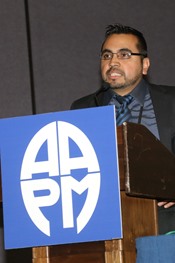Program Information
Reduction in Thermal Drifts and Noise in Radiation Calorimetry Using Vacuum Insulated Panels
E Flores-Martinez*, J Radtke , L DeWerd , School of Medicine and Public Health, University of Wisconsin-Madison, Madison, WI
Presentations
SU-I-GPD-T-484 (Sunday, July 30, 2017) 3:00 PM - 6:00 PM Room: Exhibit Hall
Purpose: The focus of this work is the design and construction of a water calorimeter using vacuum insulated panels (VIPs) for absorbed dose to water measurements in megavoltage beam therapy. Calorimeter performance is evaluated by measuring thermal drifts in a water phantom and the mean squared deviation (MSD) in temperature measurements.
Methods: A water calorimeter using vacuum insulated panels was designed and built. Each of the calorimeter walls consisted of a 2.5cm VIP sandwiched between expanded polystyrene panels. The outer dimensions of the calorimeter are (80x80x50)cm³. Temperature in a (10x10x10)cm³ glass phantom filled with water was measured using a glass-encapsulated NTC-thermistor embedded on a Wheatstone bridge circuit. Temperature was calculated using the filtered and amplified output voltage from the circuit and the thermistor calibration coefficients. The long-term MSD in temperature measurements was determined without delivering radiation. Radiation measurements were performed using 6 and 18 MV photon beams from a Varian 21 EX linear accelerator. Two hundred monitor units were delivered with an SSD of 100cm, a dose rate of 300MUs per minute and a field size of (7x7)cm². Dose was measured with the thermistor at 5cm depth and was compared with calculations.
Results: The average thermal drift of the VIP calorimeter in the linear accelerator room was 3.4±0.5 μK/s. The MSD in temperature measurements without delivering radiation was 18μK. At the investigated depth, the measured doses were 1.56±0.04 Gy and 1.90±0.07 Gy for the 6 MV and 18 MV beams respectively, while the calculated doses were 1.66Gy and 1.87Gy. Differences up to 4% were anticipated due to the heat defect contribution to the overall uncertainty.
Conclusion: A reduction in thermal drifts and noise can be achieved by the incorporation of novel insulation materials in radiation calorimetry. Novel measurement techniques such as interferometer-based calorimetry will benefit from such reduction.
Contact Email:
